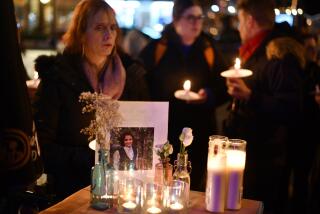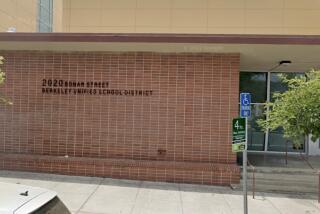Recognizing the perils of bullying
- Share via
To many adults, teasing and taunting among children and teenagers are natural and inevitable parts of growing up. But, as a new school year begins, experts say such behavior is anything but normal.
“Bullying is a public-health problem [tied to] the larger issue of youth violence in this country,” said Joseph Wright, medical director of advocacy and community affairs at Children’s National Medical Center. Allowing it to go unstopped, he said, fosters crime and mental-health problems that can last into adulthood.
Wright and other child-health experts urged parents, teachers and community leaders to give the problem greater attention following the publication of a study done in rural Germany of 22 adolescent boys who had bullying behavior, and who were treated with six months of family therapy sessions. The report, which appears in the August issue of the journal Pediatrics, is a reminder that the United States lags behind other countries in dealing with bullying, Wright said.
“We are really just at the recognition phase [in the United States].... We have defined the problem and are recognizing the problem and trying to adapt,” Wright said. “This [study] just points out how far behind we are in even accepting bullying as something that’s not a normative behavior.”
At least 22 states have passed anti-bullying laws since 1999, some motivated by a 2002 U.S. Secret Service report that found that bullying had played a major role in several school shootings, according to the National Conference of State Legislatures.
The intent of such laws is to prohibit intimidation, bullying and harassment in schools, reports the conference. Defining these unacceptable behaviors has been challenging, but guidelines generally consider the length of time that threatening behavior has persisted and whether a perceived imbalance of power lets a student or group of students victimize others.
The German study described measurable reductions in anger and improvement in quality of life and interpersonal relationships after family therapy. But several U.S. child-health experts said that, because the study included only families who lived in rural areas, the findings are not likely to be applicable to large, urban school systems in this country. They also doubted that family therapy by itself could offer a solution, and disagreed with the measures used in the study to identify bullies.
U.S. researchers who have studied bullying say part of the problem is that such behavior is often accepted, even encouraged by adults.
“There’s a real value system around [bullying] that basically teaches kids that it’s not just OK -- it’s more than OK,” said Howard Spivak, a professor of pediatrics and community health at Tufts University in Massachusetts. “Social acceptability of bullying is a consequence of many complex things,” including adults’ approval and the influence of television, video games and movies that “teach them that being mean is not only acceptable, but good.”
More than 16% of U.S. schoolchildren report having been bullied, according to a 2001 survey of nearly 16,000 students in grades six through 10 funded by the National Institute of Child Health and Human Development. An estimated one-quarter to one-third of U.S. students are involved in bullying, either as a victim or perpetrator, Spivak said.
Research has linked bullying with violent and criminal behavior later in life, as well as emotional, psychological and social problems. A federally funded study published in the Archives of Pediatrics & Adolescent Medicine reported in 2004 that bullies and their victims had more health problems and poorer emotional and social adjustment than their peers.
But that relationship is often poorly understood by parents and school officials. Parents often “have some concern if their kids have been victimized,” said Bennett Leventhal, a child and adolescent psychiatrist and professor of psychiatry at the University of Illinois at Chicago College of Medicine. “But there are a lot of people who believe that bullying builds character, [that] if you get through it, you’re better off.” He called that thinking dangerous.
According to the Department of Justice, bullying encompasses a variety of acts repeated over time that involve “a real or perceived imbalance of power, with the more powerful child or group attacking those who are less powerful.” Bullying can take any of three forms: physical (spitting, pushing, stealing, hitting and kicking), verbal (name-calling, teasing, taunting and making threats) and psychological (social exclusion, extortion, intimidation, spreading rumors and manipulating social relationships).
The National Institute of Child Health and Human Development survey found that bullying was especially common in sixth, seventh and eighth grades. Principal players include the bully, the victim and a third type who alternates between the two roles.
Research shows bullying can make students reluctant to leave home or attend classes. About 5.4% of ninth- through 12th-graders reported feeling “unsafe at school or on [the] way to or from school” on at least one day in the month before they were surveyed in 2003 by the Department of Health and Human Services.
Betsy Pursell, executive director of the Empower Program, a Washington-based nonprofit that teaches strategies for dealing with bullying and aggression, called that a logical reaction. “Students can’t focus on their academics if they’re worried about walking through the hallways,” she said.
Bullying’s link to violence has been documented. For example, the 1999 Columbine High School shootings in Littleton, Colo., by two students who were among many who had been bullied, resulted in the deaths of 12 classmates, a teacher, the shooters themselves and the wounding of 23.
The Secret Service initiated its investigation after the Columbine attacks, and released its Safe Schools Initiative report in 2002. The agency, joined by the Department of Education, studied the causes of 37 cases of “targeted violence” -- in which a school was “deliberately selected as the location for the attack” -- that took place between 1974 and 2000, according to the report.
“In some of these cases the experience of being bullied seemed to have a significant impact on the attacker and appeared to have been a factor in his decision to mount an attack at the school,” the Secret Service report states. “In one case, most of the attacker’s schoolmates described the attacker as ‘the kid everyone teased.’ Schoolmates alleged that nearly every child in the school had at some point thrown the attacker against a locker, tripped him in the hall, held his head under water in the pool or thrown things at him.”
A variety of programs aim to reduce violence and bullying in schools. A New York-based organization, Operation Respect, provides training for teachers, school administrators, students and parents, helping them adopt behaviors and rules conducive to a peaceful school environment.
One well-regarded approach, developed by Norwegian researcher Dan Olweus, has been the model for many U.S. programs. His method -- which involves school-wide, classroom and individual interventions -- has been thoroughly researched and is frequently cited in bullying research. The program includes parental, school and student involvement and calls for school rules against bullying and anonymous student questionnaires to assess the prevalence of the problem.
Effective anti-bullying programs need to involve all of the “stakeholders: kids, teachers, administrators [and] parents so that bullying is not a behavior that’s rewarded” and instead is seen as an act with consequences, Spivak said.
Identifying bullies requires creating an environment for students to open up, agree experts. “The best way to find out whether someone is a bully is to ask kids,” Leventhal said.
What parents should look for
Addressing children’s violence toward or intimidation of other children is not just the role of teachers and school administrators, say child-health experts. Parents also play a crucial role in recognizing and reducing opportunities for such behavior. Parents should assume their children “are either involved in bullying or have seen it,” said Bennett Leventhal, a child and adolescent psychiatrist and professor of psychiatry at the University of Illinois at Chicago College of Medicine. The trick is getting them to talk about it. Leventhal’s suggestion: Rather than asking “if” kids have seen or been involved in bullying, ask, “What about when you were bullied?” and “When have you picked on other kids or just stood by and watched when it happened?” Then ask how the situation made them feel and ask if you can help. Some changes in behavior patterns may also signal a child’s involvement in bullying -- either as victim or perpetrator. But because these warning signs may also have other causes, say experts, it is important that parents talk with their children and seek professional help if needed.
*
(BEGIN TEXT OF INFOBOX)
Signs of being a bully
* Aggressive, spiteful, oppositional, dominating, manipulative behavior.
* Enjoys insulting and teasing others.
* Fighting and getting into trouble at school.
* Using physical means to express anger.
Signs of being a victim
* Bruises, cuts or other injuries with no credible explanation.
* Damaged clothing or lost possessions without good explanation.
* Loss of interest in school or fear of going to school or taking school bus.
* Drop in grades.
* Choice of unusual route to go to school.
* Changes in eating, sleeping and other habits, including poor appetite, nightmares and mood swings.
* Symptoms such as headaches or stomachaches.
Tips for parents
* Seek the help of your child’s school psychologist, counselor or social worker in addressing bullying concerns. Ask if there are anti-bullying school programs you can join.
* Reward good behavior with positive feedback. Avoid using physical methods to punish children for bullying. Be a good role model by not being aggressive or bullying in your own interactions.
* If you observe bullying, stop it right away.
To learn more
* Operation Respect, www.operationrespect.org.
* National Assn. of School Psychologists, www.naspcenter.org/factsheets/bullying_fs.html.
* U.S. Department of Justice, “Addressing the Problem of Juvenile Bullying” (a fact sheet), at www.ncjrs.org/pdffiles1/ojjdp/fs200127.pdf.
* Centers for Disease Control and Prevention, “The Bully Roundup” (an interactive board game) at www.bam.gov/sub_yourlife/yourlife_bullyroundup.html.
Sources: Expert interviews and the National Assn. of School Psychologists bullying fact sheet.
From Washington Post
More to Read
Sign up for Essential California
The most important California stories and recommendations in your inbox every morning.
You may occasionally receive promotional content from the Los Angeles Times.













